FourStar User GUIs
2012-01-25

Location of this document:
http://instrumentation.obs.carnegiescience.edu/Software/FourStar/stargui.html
The 'StarGUI' runs on a Mac/Xserve computer and is written in the programming
language 'C' utilizing the 'Carbon' framework.
All communication of the GUI with other components is done via
the ethernet nework (TCP/IP sockets) and therefore does not require
any special drivers.
'StarGUI' is the user interface for the observer; its main
window shows all controls necessary to start an exposure or
run a sequence of exposures and telescope moves (dither-macro).
Index
- Camera
- Macros
- Macro Commands
- Data Display
- Telescope
- SkyMap
- Object Lists
- Airmass
FourStar Software Main Page
Camera GUI
This window is the main user interface for the observer; it
shows all controls necessary to start an exposure or
run a sequence of exposures and telescope moves (macro).

Exposure group:
- ExpTime edit field
- The exposure time can be set in multiples of 1.456 seconds
(ie. the cycle time of the ASIC code).
- ReadMode popup-menu
- The 'ReadMode' may be set to take double correlated
exposures or Fowler samples (multiple endpoints).
- Gain popup-menu
- We implemented two gain settings; the 'FullWell' setting
utilizes a higer gain (2.5 e/DU) and is better suited
for broad-band imaging, while the 'LowNoise' setting (1.5 e/DU)
minimizes the effective read noise.
- FilterCombo popup-menu
- The software abstracts the two filter wheels, the field flattener
and a variable pupil to a 'FilterCombo' that automatically selects
the appropriate combination of optical elements.
Loop-Sequence group:
- Go button
- Starts a loop-sequence.
- Loops edit field
- Defines how many exposures are taken per sequence.
Loops of up to 64 exposures may be taken by pressing the 'Go'
button of the GUI.
- Object edit field and object type popup-menu
- Comment edit field
- are written to the FITS header; the object type
is selectable from a list (eg. 'astro' or 'standard').
Macro group:
- Execute button
- Execute the macro file in the File edit field.
- File edit field
- Macro file name to be run. If the name does
contain a full path the system looks for it
in the $HOME/Library/Application Support/FourStar
folder.
- Select button
- Opens a file selector dialog.
- Line
- Displays the current macro line that is beeing executed.
- Pause button
- Pauses the running macro. A dialog "prepare to pause"
will open that switches to "macro paused" after
the current command has finished.
- Create Dither button
- Create Stare button
- Opens a dialog that lets the user customize prefefined
macros types. These tools allow to easily create
complex macros.
See the Macros chapter for details.
- Abort button
- Aborts the running macro and exposure loop.
The data is simultanously written to upto three different
disks. Usually the first disk is the internal disk of the
Control-Mac, serving as an online backup for the raw data.
The second disk is the RAID array that allows the
data pipeline to reduce the data in
near realtime. A third path may be set to write the
data to an (oberserver supplied) USB disk. Writing to the
USB disk in parallel creates a small delay (about 2 seconds per loop)
and is not recommended for short exposure time sequences.
Macros
Macros are ASCII files (extension .macro)
that contain a list of commands
that will be executes sequentially, ie. there are no commands
that allow to affect the program flow.
The CameraGUI provides two tools that allow to
easliy create commonly used macros. Custom macros
may be written using any text editor. A complete
list of commands is given below.
Dither Macros
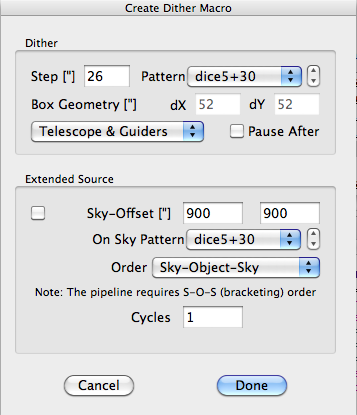
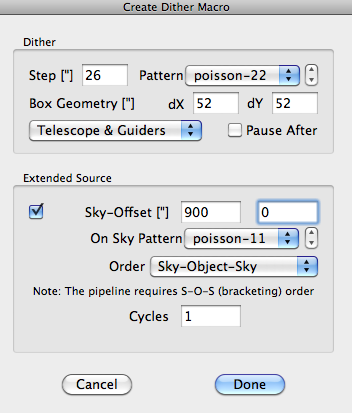
The example on the left creates a dice5 macro
with a step size of 26 arcseconds, rotated by 30 degrees
(dice5r30_26c.macro).
The example on the right creates an extended source macro
(sos_p11_p22_26c.macro)
that does a
poisson-11 pattern at the sky position (900 arcsec east), then a
poisson-22 pattern at the object position, then a
poisson-11 pattern at the sky position
The observer may choose from a number of standard patterns
(eg. dice5 or square9) or may create a randomized
dither pattern of a given size and number of positions.
The 'random' (start at the center) and 'poisson' (start at random position)
patterns are created using a
'Travelling Salesman' like optimization algorithm.
The software first creates a random pattern
of 'n' positions within a box with
width = height = 2 * step_size
that fulfill the following restriction for the distance between
any two points
min_dist > [ sqrt(2) * step_size ] / sqrt(n)
In the second step the software optimizes the path through
all points by minimizing a cost function
cost = SUM(i,j=1..n, i!=j) { ABS[dist(i,j) - step_size]^3 }
This function avoids very short moves while still minimizing
the overall path length and therefore the total runtime of
the dither macro.
The Macro tool also allows for repeating a (different) pattern
on and off the sky to faciliate the imaging of extended sources.
Stare Macros
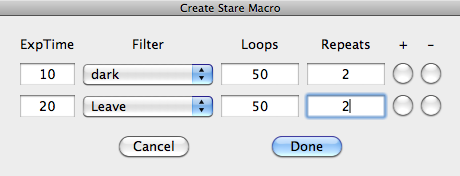
Example stare macro
The Stare macro tool lets the observer create
calibration macros (ie. no telescope offsets) or allow
long exposure sequences that exceed the loops limit (64).
The example above creates a macro that takes 100 darks
at an exposure time of 10 seconds and then another 100
at 20 seconds exposure time.
Macro Command List
- go [nloops]
- Start exposure loop. The optional parameter sets the
number of Loops in the GUI.
- move dx dy
- Offset the telescope by dx (arcsec in R.A.) and
dy (arcsec in Dec.).
- move_coord dx dy
- Offset the telescope by dx and dy
(same as move)
and move the guiders in the opposite direction. This
command turns the guiding off before the move and
turns it back on after the move.
- move_coord_async dx dy
- experimental telescope offset that only waits
for the telescope offset and continues the macro before
the guider probes have reached their destination position.
- guiding {0,1}
- Turn guiding off or on. This command is implicitly
executed before/after coordinated telescope/guider offsets.
- filter name
- Set the filter-combo name (from list in popup menu)
- readmode name
- Set the readmode name (from list in popup menu)
- exptime value
- Set the exposure time to value
- gain name
- Set the gain to name (from list in popup menu)
- obstype
- Set the observation type to name (from list in popup menu)
- pause
- Pauses the macro and opens a dialog box that allows to
resume the macro.
- sleep value
- Delays the macro execution for value seconds.
- exit
- Stop the macro. This command is optional; if there is
no exit command the macro stops after the last command.
Data Display
The 'Quick-Look' tool displays all four arrays (pixel averaged)
in the 'Overview' window at the proper sky orientation. A
simplified compass rose (green circle) points North and East.
The data can be viewed at various color mappings
and may be scaled manually or automatically.
The scaling algorithm may
be set to use the entire data range of all four arrays or
scale each indiviual array separately to improve contrast.
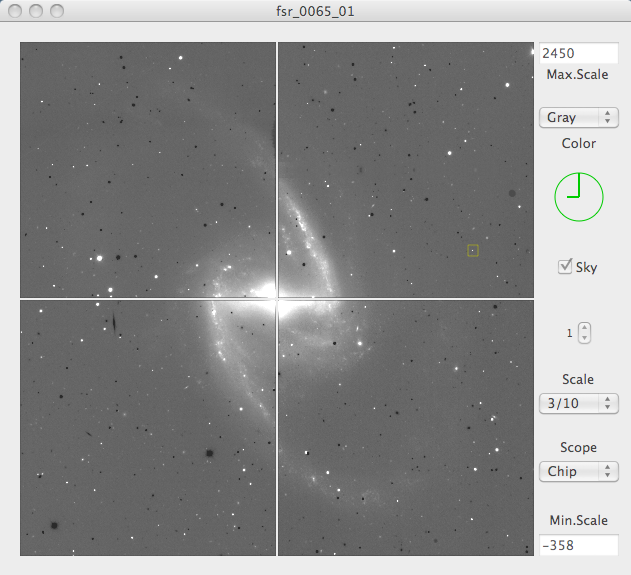
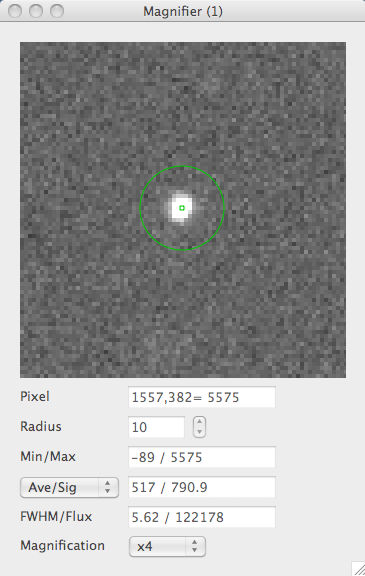
The 'Quick-Look' tool may either show the raw data or
use any previously data image to display a sky-subtracted
image. All exposures of a loop are kept in memory and
may be inspected by clicking the up/down arrow on the GUI.
A magnifier window allows the observer to zoom into any area
and inspect the data. The tool shows the minimum and maximum
pixel values and also calculates the average and
standard deviation within a circular aperture of a given radius.
Finally the tool calculates an estimate of the FWHM (in pixels)
of an object at the cursor position.
Telescope
The 'Telescope-GUI' displays basic telescope related information
like coordinates, current airmass and sidereal time.
It allows the observer to initiate small offsets, either
just moving the telescope or coordinated offsets where the guider
is moved the same distance in the opposite direction.
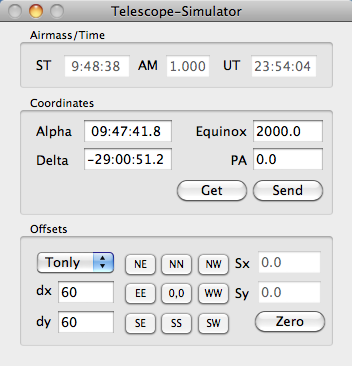
SkyMap
The 'SkyMap' window displays a star catalog (GSC, USNO-A, 2MASS)
superimposed on the field-of-view of the four arrays.
The view may be zoomed-in or -out. A 'click' on a star reveals
its brightness (eg. J,H,Ks magnitudes for the 2MASS catalog).
Each exposure taken leaves an imprint of the arrays on
the map. This allows the observer to visually track the
progression of a dither-macro.
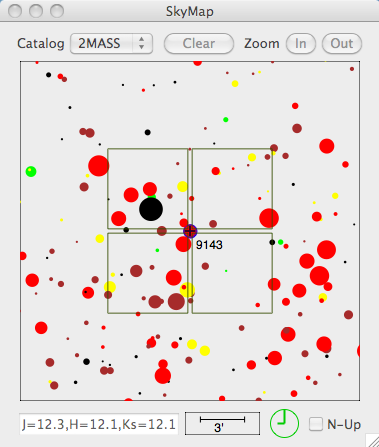
Object Lists
The 'Object-List' window can load simple ASCII files created
by the observer in preparation for each run. Entries may be
edited or created "on-the-fly". The coordinates of any object
may be sent directly to the TCS (telscope control system),
thus avoiding communication errors between the telescope operator
and the observer. The object-list display may be sorted by
any of its fields by clicking on the column header.

Airmass
The 'Airmass' window displays the change in airmass over time
at the current pointing. The GUI can be set to any coordinates
without moving the actual telescope, allowing to predict the
airmass development of objects in the object-list.

Index
2009-04-08,
Christoph C. Birk, Carnegie Observatories









